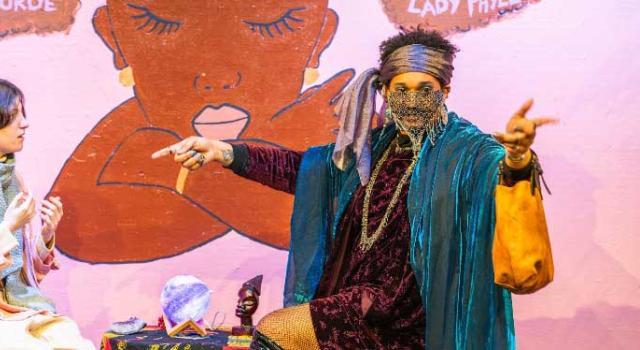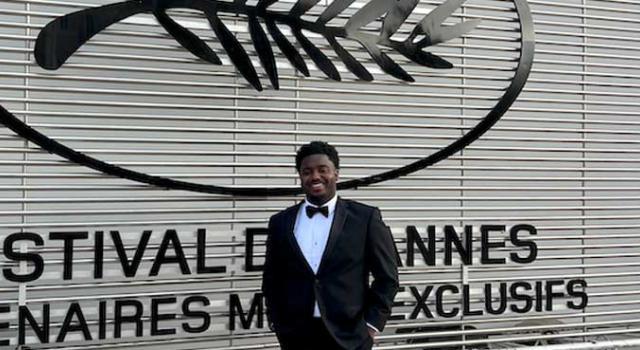Brooke Huguley 17F Examines How Reproductive Justice and Embodied Movement Can Heal Trauma

During a field study in Ghana, Huguley performed doula work at a small rural hospital. This experience became a catalyst for her research on birth inequities and how to disrupt them.
Brooke Huguley 17F began her Div III journey on the first day she stepped foot on campus (literally). We sat down with the recent Hampshire graduate to learn more about the path to her Div III in reproductive justice and embodiment and why Huguley describes Hampshire as an “abundant cosmic rainbow.”
What brought you to Hampshire?
I am from Austin, Texas, and grew up with a very alternative education of homeschooling and unschooling. I was trying to find a college that was in alignment with that upbringing, and my mom and I were doing a lot of research around that. I was on the fence about Hampshire until I came to their Accepted Students Day event, and I immediately felt so at home!
How did you first get interested in the themes of your Div III, namely reproductive justice and embodied movement?
On the first day that I actually came to Hampshire and toured the school, I met alum Jamila Umi Jackson 14F. She and I immediately clicked, and she took me under her wing. I began to work closely with her on her embodied leadership project. There was also a doula training happening at Hampshire my first semester and I applied and received a grant for it. That training was a very formative experience, and it got me on the path to taking a lot of reproductive justice classes that were very influential to me. Many of those classes focus on the body, and since I was also simultaneously working with Jamila around embodiment, I started to think about embodiment and all the multiplicities that embodiment holds in conversation with reproductive justice.
I think my favorite class I ever took was in the second semester of my first year: Embodied Community Dancing taught by Jodi Falk. She showed us how to use embodiment as a healing tool specifically in community spaces. The first half of the semester we spent studying ways of engaging with groups of people using embodiment and ways of connecting with different parts of the community, and then we went into the community and danced at senior citizen homes and at a home for incarcerated juveniles. That was when I really saw that there is something special in embodiment, especially with working with groups of people that are not really seen and recognized by the pervading society.
Can you talk more about your Div III project?
My Div III was actually two large projects, a nearly 200-page thesis paper that looks at reproductive justice globally, and a film that examines the topic from a more visual lens. My committee chair was Visiting Associate Professor of Anthropology Pamela Stone and my other committee member was Associate Professor of Dance and Performance Curation Deborah Goffe.
I had an intense field study in Ghana in the fall of my third year, where I performed doula work at a small rural hospital. I witnessed women enduring a lot of obstetric violence, and that was the catalyst in continuing my research of birth inequities and also how to disrupt them. Since my interest is really with the body, a lot of my research was centered around thinking about the body and thinking specifically about the trauma that women undergo.
My thesis unpacks that whole experience and grounds reproductive justice in a global context. It then goes on to look more deeply at Black women's identities and Black women's experiences, specifically in the U.S. There are two chapters in my Div III that are case studies exploring my paternal grandmothers’ experiences and the reproductive injustices that they endured. My last chapter talks about embodiment as healing and why linking ancestry and talking about ancestry is important, and how embodiment as intervention can be a way that Black women can access some form of freedom and liberation outside of the systemic injustice that is so embedded and so hard to disrupt.
The film I created serves as a visual representation of the paper. I’m a very visual person and I'm also a dancer, so I felt I needed to have an artistic component to the project.
What is next for you and your work?
I’m looking into publishing my paper as a book! Long term, I’m thinking about graduate school to become a dance movement therapist who focuses on helping women and women of color with traumas that are specific to them.
How would you describe Hampshire / What advice would you give to future Hampshire students?
Hampshire is like an abundant cosmic rainbow—an explosion of creativity and art and personalities and beautiful people. Allow yourself to take whatever classes interest you and don’t worry about how they’ll intersect. Just follow and trust that internal guidance whispering in your own head. Do things that surprise you, and then just like that, it will all work out!



